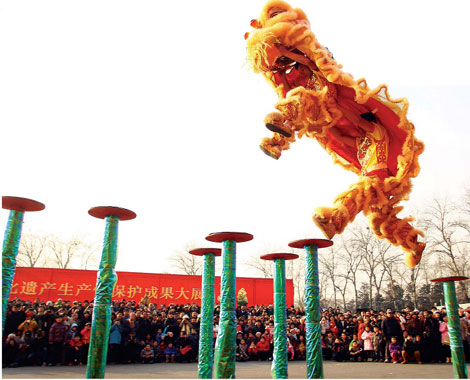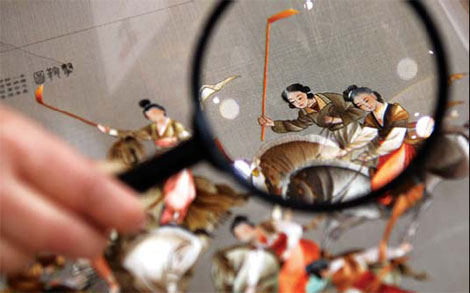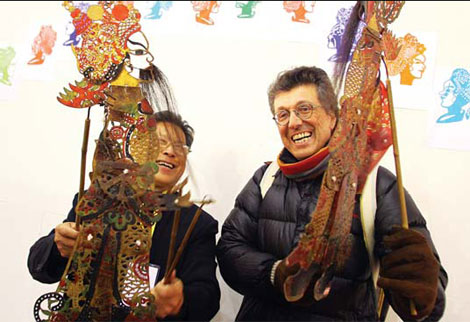Commercializing culture
Updated: 2012-02-16 10:55
By Mu Qian (China Daily)
|
|||||||||||
 |
|
Two lion dancers from the Huang Feihong Lion Dance Troupe perform at Exhibition of Achievements on the Productive Protection of China's Intangible Cultural Heritage. Photos by Zou Hong / China Daily |
 |
|
An embroidery by national intangible heritage inheritor Zhao Hongyu from Wuxi, Jiangsu province, is displayed at the exhibition. |
 |
|
Spanish visitor Sangit Prats learns shadow puppetary with Liu Nianhua, an intangible heritage inheritor. |
A massive exhibition with performances in Beijing examines intangible heritage protection through profit generation. Mu Qian reports.
Beijing returned to normal after the Lantern Festival, but the festive atmosphere lingered at the National Agriculture Exhibition Center, where folk dancers staged nightly shows. But they didn't simply present traditional dances. They also demonstrated the modern trend of "productive protection", in which intangible cultural heritage is sustained by free market commercialization. A group of lion dancers from Nanhai, Guangdong province, performed twice a day in the venue's courtyard between Feb 5 and 15.
They participated in the Exhibition of Achievements on the Productive Protection of China's Intangible Cultural Heritage, which ended on Feb 15.
Performer He Cantian says: "I'm happy to present this tradition from South China's Guangdong province to North China's audiences in Beijing. It's not just a local tradition but also a form of national intangible cultural heritage."
As drums and gongs clashed, the lion leaped onto and balanced on two poles - no easy task for He and his partner.
Guangdong's lion dance is based on its local kungfu style. He's Huang Feihong Lion Dance Troupe takes its namesake from the martial arts school's master. He's teacher studied under Huang's descendent.
"My teacher always says every generation of lion dancers should do what they can to pass down the tradition," He says.
The 27-year-old and his fellow lion dancers are doing so by making it their profession, he says. He studied the folk performance art as a child and went pro in 2006. Their team regularly stages shows at the Huang Feihong Guild Hall in Guangdong's Nanhai. They also perform at such occasions as weddings, birthday parties and company events.
"Since lion dancing is how we earn our living, we must do it really well," He says.
He's dance troupe is one of four performing at the Beijing event.
Others presented the dragon dance of Chongqing, yangge of Shandong province, "nine lions" dances from Zhejiang, and the Taiping drum dance from Beijing. All are professional or semiprofessional.
Besides the dances, the exhibition brought about 170 folk artists to the venue to demonstrate their skills in creating pottery, embroideries, wood sculptures, weavings, paper-cuts and traditional Chinese medicine.
About 2,000 items from 188 categories were showcased at the exhibition, which was the largest of its kind in China. It was sponsored by the Ministry of Culture and other ministries. The National Agriculture Exhibition Center event was different from previous intangible cultural history exhibitions in its focus on productive protection.
Minister of Culture Cai Wu said in his opening ceremony speech that China should adopt various methods to preserve its intangible cultural heritage.
Others are "salvage protection", used for endangered items, and "holistic protection", used to preserve areas in which many intangible cultural heritage forms are concentrated.
"Productive protection marks the relationship between preservation and economic development," Cai says.
The Ministry of Culture recently named 41 "bases for the productive protection of national intangible cultural heritage" and will issue the Direction on Enhancing Productive Protection of Intangible Cultural Heritage blueprint.
"My understanding of productive protection is the development of folk art through tradition inheritance," says Liu Lanfang, an embroiderer from Qingying, Gansu province, which is among the 41 bases.
Qingyang is an area famous for its embroidery, and Liu has collected many local specimens. She designs new products like purses and shoes using traditional patterns.
Liu's company has 24 regular employees, but most of the embroidery is done by thousands of women farmers, who work between harvests and plantings.
"People used to regard embroidery as solely for use in the home and generally worthless, but now the handicraft generates increasing economic value," she says.
A small, embroidered cloth tiger costs 350 yuan ($56), while bigger works often cost thousands of yuan. Liu's company has opened shops in several cities in China.
"I'm looking forward to the Ministry of Culture's adoption of policies favorable to intangible cultural heritage's productive protection, which will help our work," she says.
Many of the craftspeople at the exhibition run flourishing businesses.
Quzhi, a master of thangka (Tibetan Buddhist scroll paintings), recently opened a thangka academy in his hometown Wutun, Qinghai province, that teaches 100 apprentices. A large-scale thangka work Quzhi and his students finished that was displayed at the exhibition sold for 600,000 yuan.
"The productive protection of intangible cultural heritage will not only increase enthusiasm for carrying on traditional culture but also will stimulate cultural consumption," Cai says.
The exhibition was admission-free and attracted visitors from home and abroad.
"It's a rare opportunity for us to see so many Chinese arts and culture in one place, and presented in such a nice way that enables us to meet the artists and see how colorful and diverse China is," says Gudrun Hardiman-Pollross, cultural counselor of the Austrian Embassy in Beijing.
Botswana's ambassador to China, Sasara Chasala George, says the drum and dance performances remind him of Africa. He's especially interested in the ways Chinese craftspeople incorporate traditional culture in their work.
"I like the way that Chinese people have commercialized traditional art," he says.
"Your art can be performed onstage and travel. It's not art for the sake of art. We haven't reached this stage in our country, and I hope we can learn from China."
Today's Top News
Rescuers race against time for quake victims
Telecom workers restore links
Coal mine blast kills 18 in Jilin
Intl scholarship puts China on the map
More bird flu patients discharged
Gold loses sheen, but still a safe bet
US 'turns blind eye to human rights'
Telecom workers restore links
Hot Topics
Lunar probe , China growth forecasts, Emission rules get tougher, China seen through 'colored lens', International board,
Editor's Picks

|

|

|

|

|

|





